1992 Hungarian Grand Prix: Mansell Is Finally Crowned
Senna wins dramatic race, but second is enough to secure Mansell’s first World Championship
The first 38 laps of the Hungarian GP did not follow the script that Nigel Mansell would have wished to have signed off, but the inkling of the role that Riccardo Patrese had written in for himself had already become evident on Saturday night.
After dominating each practice session, the Italian was in good form. Are you worried about team orders for tomorrow? he was asked. “Not much,” he responded, with one of his who, me? shrugs. “No. I should say that tomorrow I will be trying to win the race.”
That was bad news for Mansell, and there had already been a lot of that in the build-up to the most important race of his career.

Riccardo Patrese leads the field from lights out
Motorsport Images
The worst, it seemed at the time, had come with FISA’s edict the previous week that only pump fuel would be acceptable. Now this is a highly complex subject. In defence of what many saw as a stance on current F1 fuels that was aimed at reducing the perceived performance gap between Williams and the rest and thus making a foregone conclusion championship more interesting FISA President Max Mosley issued a statement. It claimed that the regulations had not changed since 1978 and that there had been a ‘misunderstanding’ because many teams and petrol suppliers had ‘relied on a fuel regulation which was introduced in 1991’. The cynical elements in the paddock saw this as a means merely of penalising Elf more than anyone else. “It has been drawn to FISA’s attention that this was introduced without first obtaining the agreement of all constructors as required by the Concorde Agreement. Accordingly, it is open to challenge and FISA cannot rely on it,” continued Max.
“In the Sixties and Seventies the regulations allowed Formula One cars to use only commercial pump petrol available on general sale throughout France, Germany, Britain or Italy. The best was 101 octane and all teams used this. A tolerance of one was allowed for the octane number, making 102.
“In the late Seventies, petrol stations stopped selling 101 octane fuel. Accordingly, in 1978, the CSI (as FISA was then called) introduced a rule to define this petrol and allow its continued use in Formula One. This rule has remained in force and unchanged ever since.” The week prior to the race thus saw every team that enjoyed the use of freely supplied products from the fuel manufacturers struggling frantically to remap their engines. There were gloomy predictions that everyone would have much less power, and that the Williams-Renaults would no longer be so dominant.
Well, for a time on Friday morning it seemed that way, when Berger and Senna headed Patrese and Mansell, the two McLaren Hondas lapping in the 1m 16s bracket, the Williams-Renaults in the 1m 17s. “With the new fuel regulations you can definitely feel the drop in power right across the range,” confirmed the current World Champion, and then Patrese popped in a lap in 1m 15.882s to restore the status quo. After that, the subject of fuel tended to slide into the background as the Williams-Renaults pushed forward. Their advantage all season has been a combination of fuel, engine power and reliability, chassis performance, team management and driver commitment, and a change to one component was never going to take everything away that easily.
“McLaren is still very good, but the gap between us is still about the same,” said Riccardo happily. “On a circuit like this our car has fewer advantages because it is a downforce circuit and everyone is using a lot of wing. Because of this, McLaren can use a big ‘wall’ wing, and with the Honda power they can be closer to us. So still being in front of them I think means we are about the same as before. As we saw at Monte Carlo, on another downforce circuit, they were getting closer to us. Not better than us, but closer. I think the gap is still the same here.”
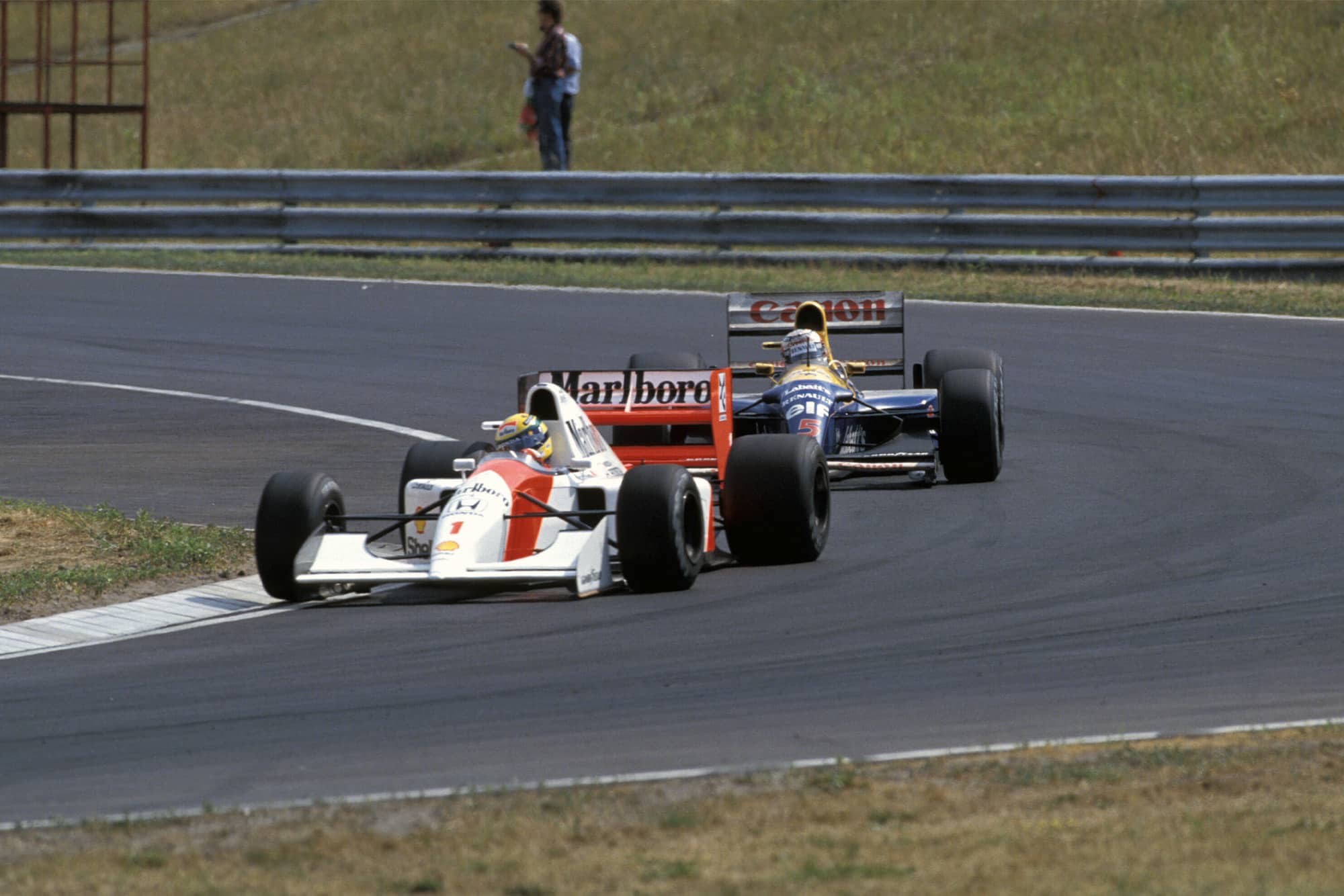
Nigel Mansell trails race leader Ayrton Senna
Motorsport Images
He would prove with consummate ease for those opening 38 laps that the Williams was still in a class of its own, beating Mansell off the line and arcing a smooth trajectory into the first corner. In his own mind Mansell saw himself squeezed sideways into the Armco, but in truth Patrese simply did the job better, and as Mansell stayed down on the dirtier inside line Senna came round him and Berger also squeezed ahead by the exit to the tight right-hander.
This was an upset to Mansell’s plans. A win would cement his title come what may, but finishing behind his team-mate would prolong the championship fight. Riccardo owned the first half, only the impressive Hakkinen (on lap six) interrupting his flow of fastest laps until Mansell stamped his mark for the first time on lap 27.
They say that overtaking is impossible round the tortuous Hungaroring, and if you are following Senna it quite clearly is. But Mansell passed Berger for third on lap eight and so nearly caught Senna napping a lap later. He didn’t quite have the momentum to sneak through, however, and thereafter the wily Brazilian had his every move covered. “I admit that all weekend I had the championship uppermost in mind,” said Mansell afterwards, and on this occasion the one thing he dare not risk was an incident with the McLaren driver. Berger slipped back ahead when Mansell got out of shape exiting the penultimate corner on lap 34, but the Briton was back in front by lap 43. By then, though, the whole complexion of the race had changed, and with it the tenor of Mansell’s performance. Going into the second corner, a tight left-hander that leads to the real downhill plunge, Patrese unaccountably lost control of his Williams on lap 39, and sat straddling the outer kerb before marshals pushed his car from its dangerous position. He had been cruising, nursing a totally dominant lead of considerably more than 30s. He had been using the brakes gently, going easy on his gear changes, taking the sensible line; and off he went. “Perhaps it was dirt on the circuit, I don’t know,” he would shrug, charged with emotion. So soon after Hockenheim, which had been bad enough, this was too much to take. He was destroyed.
That now handed Senna the lead he would not lose, although initially Mansell continued to thirst after him. But with Patrese now seventh and out of the points, the World Championship was in his pocket.
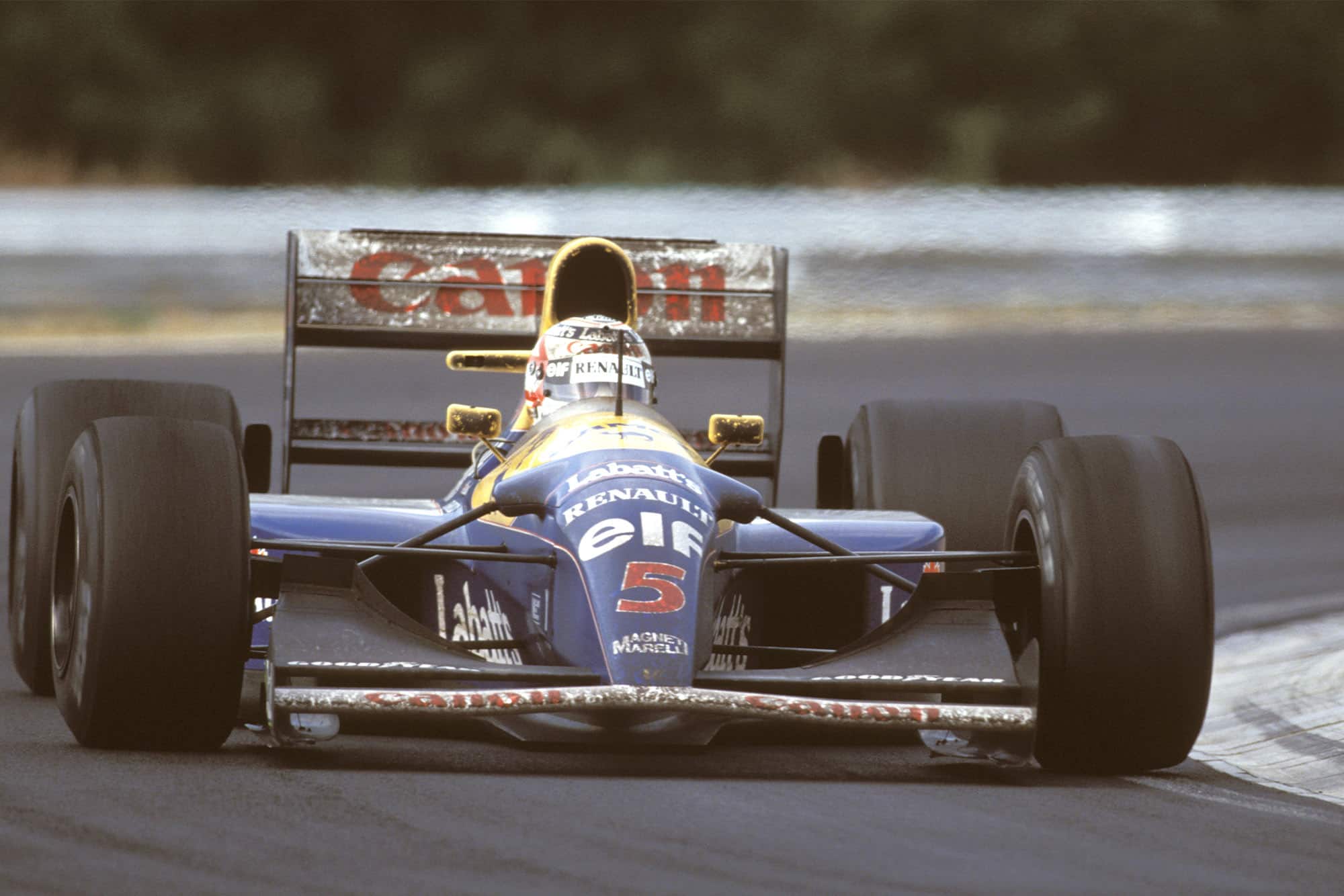
Mansell on the way to second place, good enough for the title
Motorsport Images
He has been in that position before – remember Adelaide 1986? – and he wasn’t going to take any chances. Gradually the gap to Senna began to increase, just as Berger began to drop further back, his front tyres now well past their prime. It’s a funny race, the Hungarian GP, and in the past has usually been a tyre stop event. This year the track had been totally resurfaced, however, and everyone planned to run non-stop. Mansell, Patrese, Schumacher and Brundle all cautiously chose Goodyear’s standard race Cs, while Berger, the two Lotus drivers and the two Ferrari pilots all plumped for the slightly more adventurous C left, softer D right route. Senna alone opted for Ds all round, and it proved a brilliant choice. He nursed them in the early going, as much as he could under Mansell’s fierce pressure, and then he exploited them as best he could once he got the chance to edge clear.
Mansell was convinced in his own mind that team-mate Patrese had squeezed him sideways into the barrier at the start, although all visible evidence did not support such a view. The Italian led cleanly, with Senna getting the jump on Mansell too and Berger coming round the outside. Within laps, the Hungarian GP became a classic Senna v Mansell encounter, but by the end, the McLaren mechanics indicated their feelings about Red Five’s future by donating their own race number… An incident on the opening lap between the two Ligiers resulted in instant retirement for spinner Comas and Boutsen, and also took out Herbert’s Lotus and Tarquini’s Fondmetal.
“I think I am driving as well as ever in my career,” he said afterwards, and taking Hockenheim into account as well, who would argue with that? “The sort of performance today is the product of experience. I did not to expect to win.” Nevertheless, through a combination of a good start, the luck that deserted Patrese, and canny judgement, he put together the ingredients for an excellent 35th victory.
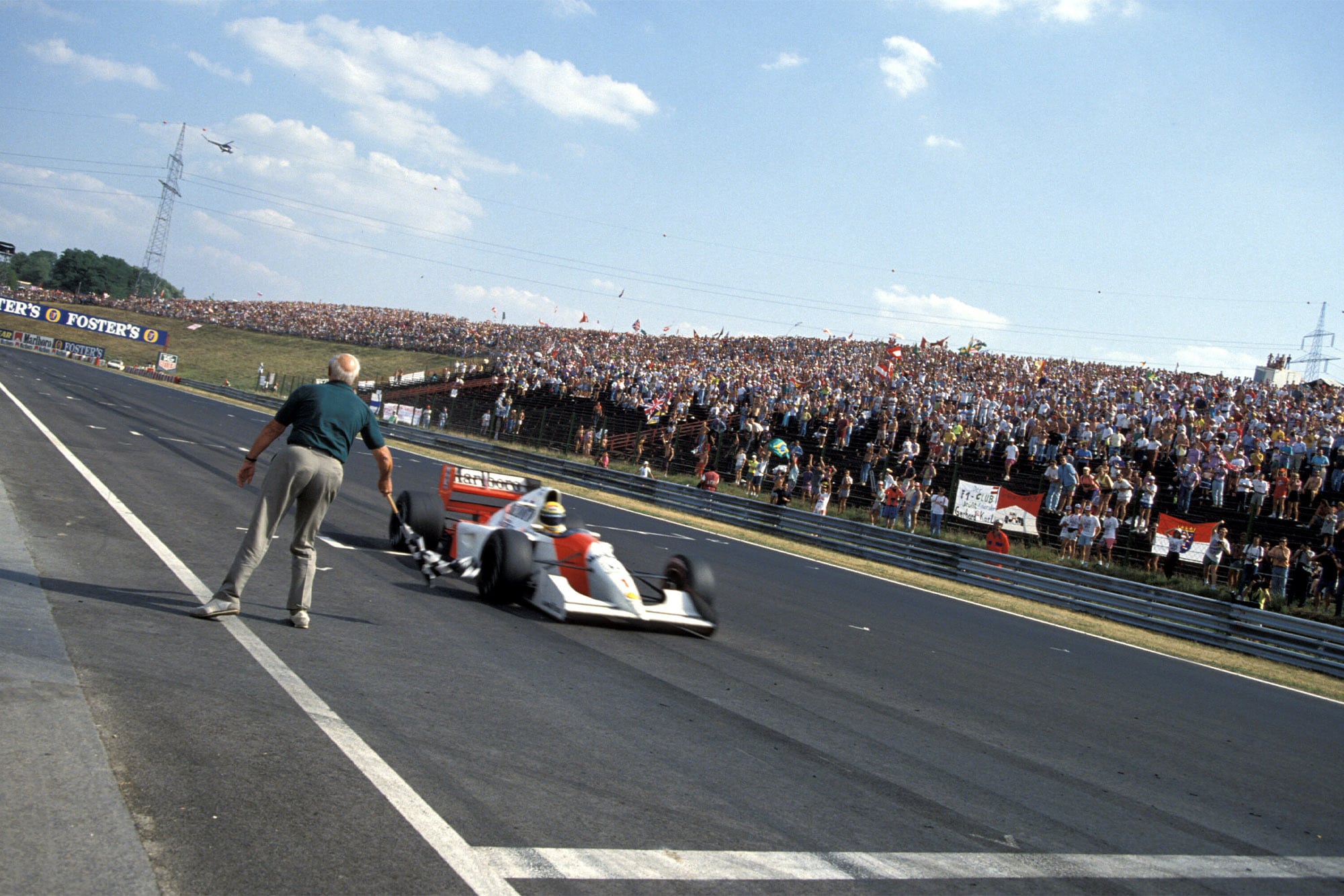
Senna takes the chequered flag
Motorsport Images
Sadly, it went almost unnoticed. In his wake Mansell was quite content to finish second for a change, while Berger had his mirrors full of Benettons. Alboreto, who had achieved Footwork’s best-ever qualifying position with seventh, held that position initially until spinning to 10th on the lap that Mansell first passed Berger. Thereafter he chased fruitlessly after Hakkinen’s Lotus as it forged by CapeIli’s eighth place Ferrari and then Alesi’s similar car. The flying Finn was spared the need to press home his challenge to the Frenchman, though, when Jean’s brio got the better of him going into the first corner and he spun into retirement. This was Ferrari’s 500th World Championship event, but once again the red cars were a mere shadow of their illustrious predecessors. Albert Obrist’s collection of historic Ferraris was augmented by some others in the Hungaroring paddock, and they were driven in demonstrations on Saturday afternoon and Sunday morning. Perhaps it was indicative of the team’s current plight that, apart from the F1/88 driven by JJ Lehto, which broke its engine, the only other one to give trouble was the F92A in Nicola Larini’s hands…
As Ferrari sunk, so Lotus came back to the fore after its disappointing showing round the power curves of Hockenheim. Johnny Herbert qualified well (and would have done better still but for a last-moment spin in qualifying by Berger which obliged both the Briton and Aguri Suzuki to spin in avoidance), but the merits of that disappeared on the exit to the first corner as Ligier team-mates Erik Comas and Thierry Boutsen tangled when the former spun. Neither continued, and Herbert was an innocent victim the way he’d been when they last collided back in Brazil. So was Gabriele Tarquini. The swift but curiously underrated Italian had put the Fondmetal in an excellent 12th place on the grid, proving that there is very little wrong with its Sergio Rinland designed chassis, but just as team owner Gabriele Rum acclimatised to that shock, new signing Eric van de Poele also spun out. It was indeed a cruel double stroke.
Throughout this intriguing event, Berger was under intense pressure. For a long while it was the irrepressible Schumacher in his wheeltracks, the German qualifying a scintillating fourth. Brundle was his team-mate’s shadow until Hakkinen forged by between laps 15 and 20, whereupon Martin found a way by again. This was serious motor racing on a not so serious track, and it certainly kept the tempo up. When Schumacher made an error on lap 33 Brundle had a spell in fourth place as Hakkinen took a breather, but when sixth gear broke in the second Benetton, Brundle found his Ford HB hitting the rev limiter in fifth long before the braking area for first corner. Schumacher gobbled him up in moments, and Hakkinen sensed blood too. Patrese had been catching the Lotus quite quickly, but then Renault suffered its first race engine failure in 18 months – a splendid record when you consider just what it entailed – when he dropped a valve in his new RS4 on the 56th lap. A race that had begun as a dream and turned into a nightmare, was finally over for the most experienced driver.
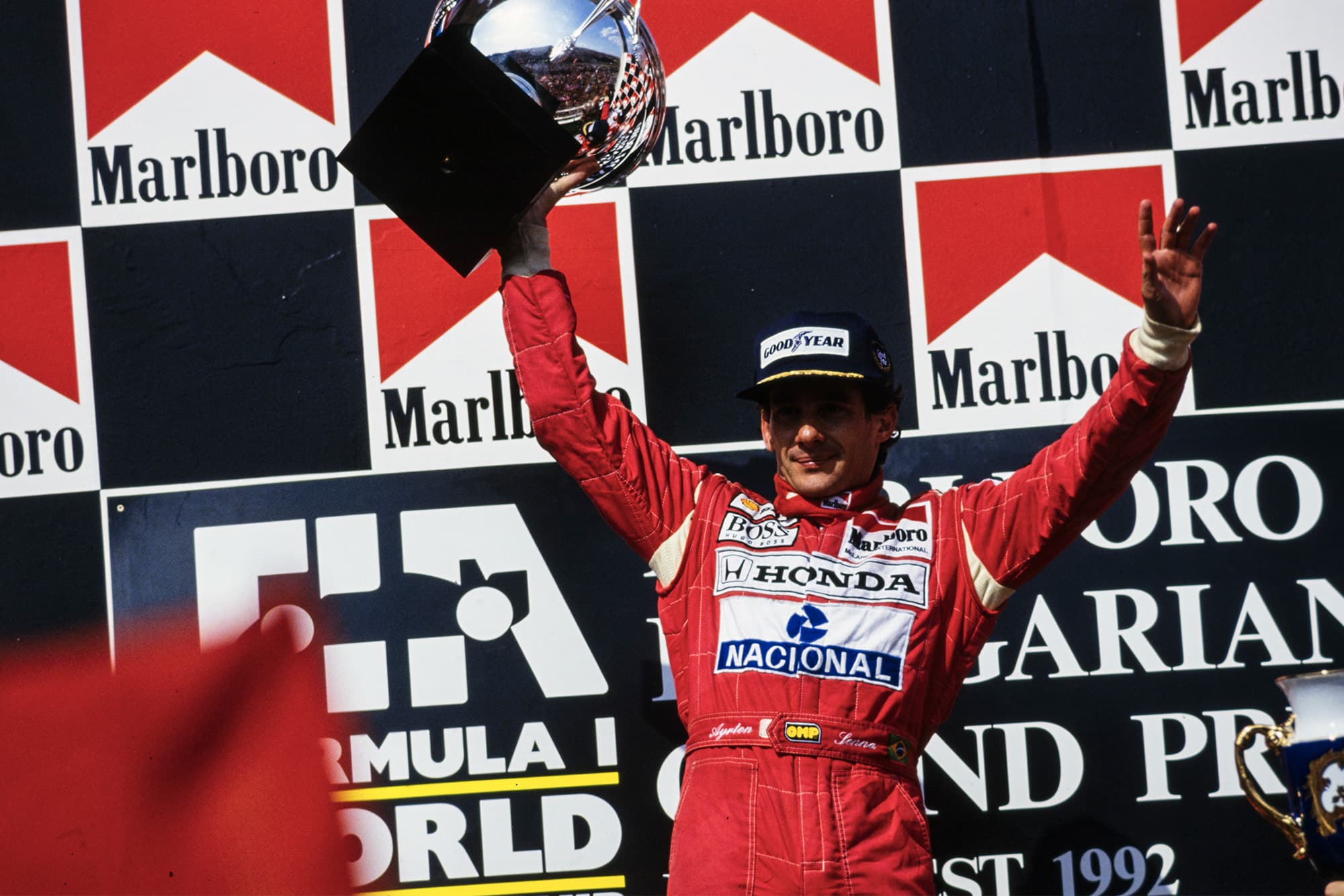
Senna celebrates his first win since the Monaco Grand Prix
Motorsport Images
Lap 62 was another turning point, for at the end of the 61st Mansell had come speeding into the pits after being warned over the radio that the pitwall telemetry confirmed that he had a puncture. It was a tyre failure that had denied him in Adelaide all those races ago, and now here was history partly repeating itself. With the sort of standing start he’d made in Suzuka in 1990 (but which then had twisted his Ferrari’s driveshafts like spaghetti) he resumed the chase, now down in sixth and with the championship wrested from his grasp yet again. In the Williams pit you could have carved something out of the tension. Schumacher’s demise had its roots in an incident at the end of that lap. As Berger slid wide and had to back off rapidly, Schumacher also lifted off sharply. Brundle, getting Berger’s message second-hand, locked his front brakes and hit the back of his team-mate’s car very hard. At the start of the 64th lap, as the German sped down to the braking area for turn one, his rear wing sheared off as a direct result, and as he was launched into at least four violent spins at maximum speed as his wing spiralled into the air to land 10 feet away from our observation point. His face impassive, he looked quietly at the offending item for a few moments as if to satisfy himself, then continued his walk back to the pits.
Brundle was now back into fourth place, and still pressuring Berger for all he was worth, and Hakkinen was now fully into the picture too, but Mansell was stalking them all. The pressure they exerted on Berger had occupied the Austrian’s every thought and allowed Senna to make good his escape, and that was to prove a vital factor for the Brazilian.
On lap 66 Mansell took fourth from the Lotus, and Brundle succumbed a lap later, their tyres no longer a match for Mansell’s fresh Ds. Two laps later, Mansell went steaming by Berger into turn one and it was, it finally seemed, all over. Second place was again good enough. The race, however, had not completed its twists, for on lap 67 Senna suddenly dived into the pits, for a precautionary tyre change. Without Mansell’s puncture he could never have hoped to come in and get out in the lead, but by now he was far enough ahead, and the vibrations from his worn Ds were so bad that he was beginning to fear that an electrical component would suffer. It was perfect judgement allied to finely executed teamwork, and he resumed the lead with barely a break in his rhythm.
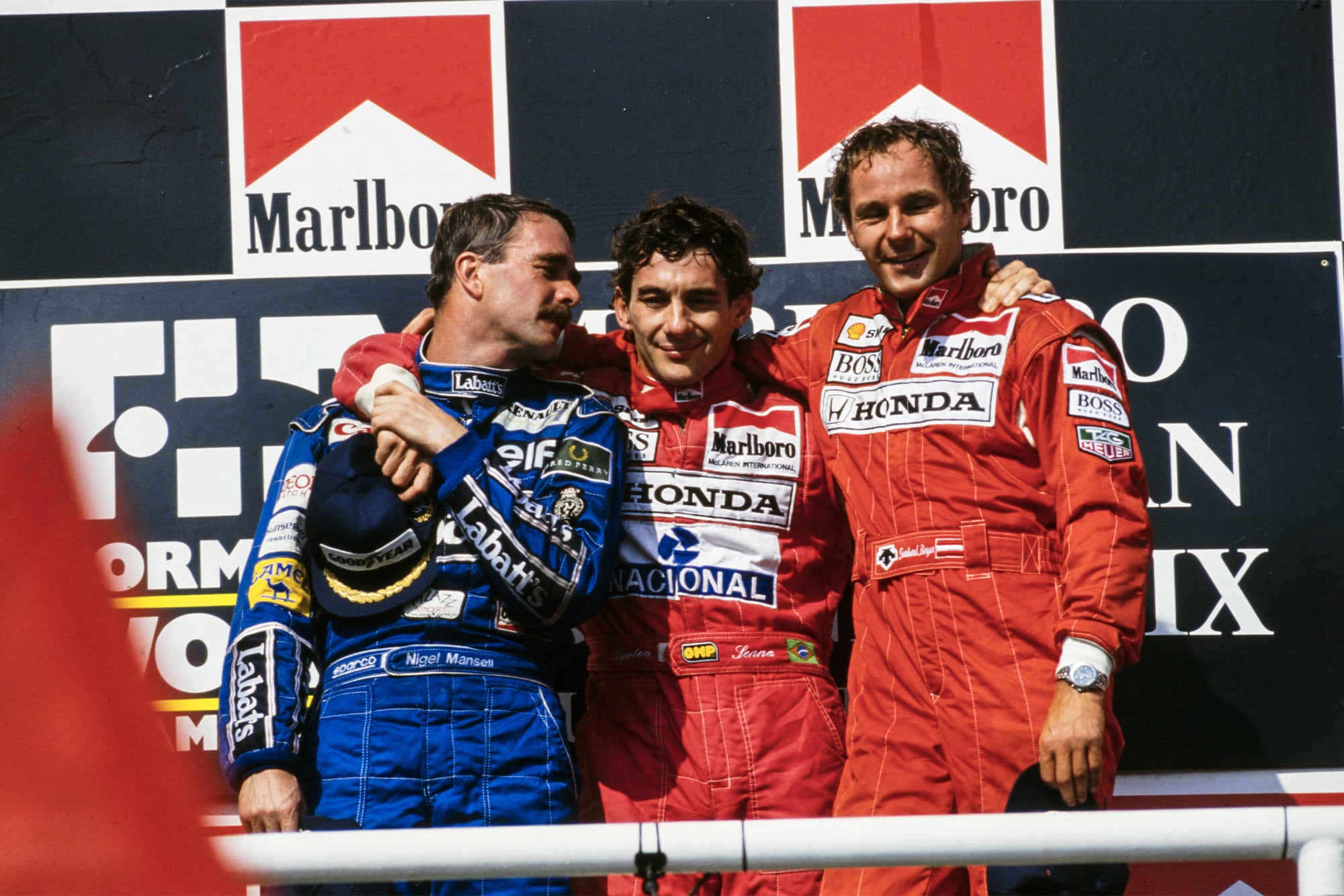
Senna stands as the winner alongside new world champion Mansell and team-mate Berger
Still things were not over, for Hakkinen and Brundle were still after Berger, the Finn having executed a super overtaking move round the outside of the Englishman going into the first corner on lap 73. However, on the last lap he bodged an attempt to box Berger in behind Capelli in the corner at the back of the pits, where Mansell had earlier run wide and lost a place to the Austrian. As Mika banged down to fourth gear he locked the back wheels and as the engine died the Lotus twitched into a spin. He would be lucky. As Brundle had to take to the gravel to avoid him, he managed to jump-start the Ford HB and get going before the Benetton clawed its way back on to solid tarmac, and the two of them made the line in the same respective positions after losing a lot of ground to the McLaren. For the Finn in particular, charging from 16th on the grid to fourth was a splendid achievement, worthy indication of his long-term potential.
By that time, Mansell was already letting the euphoria of the most important success of his life flood through. He had lost the day’s battle, but won the year’s war, and the World Championship crown was his at last.
“Will you tell us now that you believe it?” he was asked afterwards. “Just finding the words is the problem…” came the reply. After the heartaches and frustrations it was almost too much to take in. Nigel Mansell, the Nearly Man, the eternal runner-up, had finally made the transition from underdog to over-dog. And Williams, Renault and Elf, had finally wrested away a championship from McLaren, Honda and Shell. Only the constructors’ laurels remained to be confirmed. D J T
